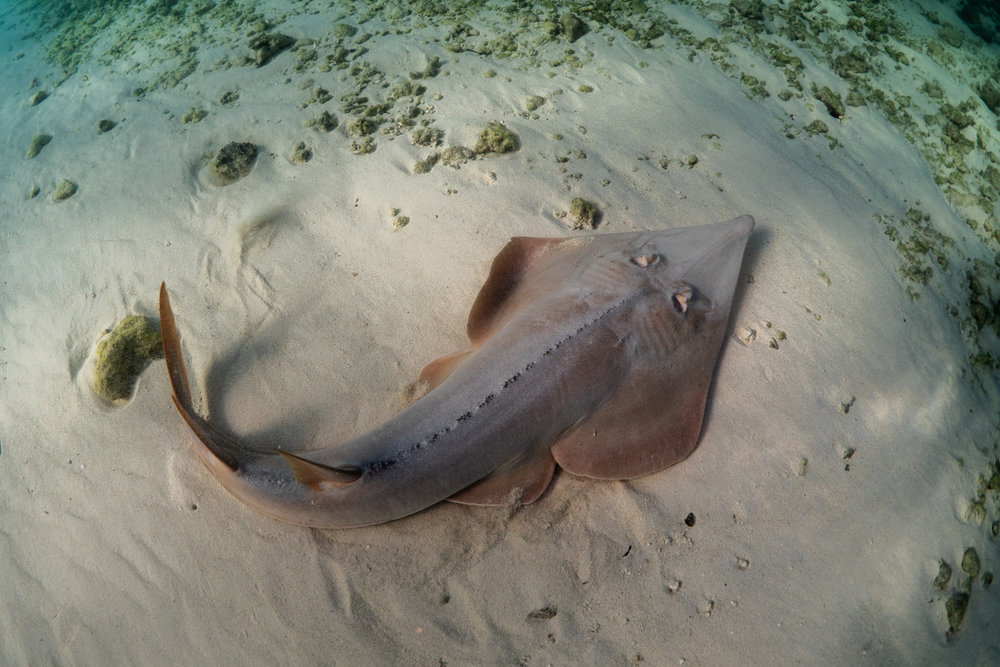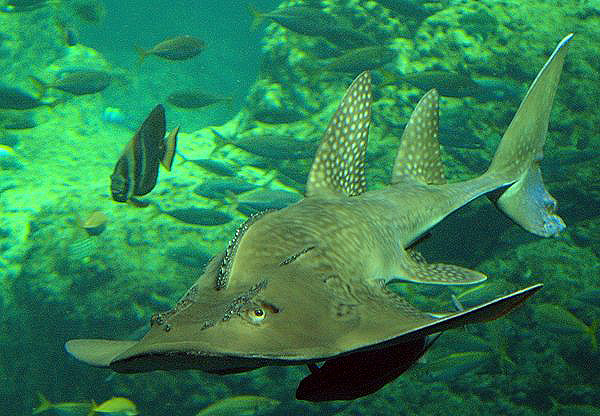Safeguarding Guitarfish CITES 2022
Laurie King
Guitarfish once roamed the coasts of nearly half the countries in the world, but they are now rare. That’s because guitarfish species suffer similar threats to their survival as do sharks and shark-like rays. The main threats are commercial fishing to supply the shark fin trade, subsistence fishing to supply meat to growing coastal populations, and habitat degradation. In recent years, governments have acted to list many shark-like rays onto CITES. This year, for the first time, there’s a good chance that some guitarfish can also be protected from unregulated trade.
The proposal seeks to include six species in Appendix II, which regulates trade in a way that ensures the species’ survival. Due to similarities in the appearance of traded products that make the identification of specimens caught in fisheries difficult, and the IUCN Red List classification of many other species as threatened, all remaining species in the family Rhinobatidae are included as lookalikes in this proposal.
A guitarfish is a medium-sized cartilaginous fish similar to a ray. Its body looks like a guitar when viewed from above, hence its name. While guitarfish haven’t been studied a great deal, we do know that the species R. rhinobatos matures at about four years of age and can live as long as 24 years. Further, they have been found to have only between two and 16 young per year. The COP19 proposal makes the point that it takes a long time for these species to reproduce and will therefore take time to recover their population size to a sustainable level.

Threats to Guitarfish
Statistics are sparse but show a substantial decline in the populations of these species. Below is the recap from the CITES Secretariat’s recommendation summarizing population data for the family Rhinobatidae. It can be found at cites.org in the Conference of the Parties 19 pages.
A. variegatus: There are no data provided for the population trend for this species. The supporting statements provide an estimate of 60% catch rate decline based on guitarfish and wedgefish landings in Tamil Nadu (Rage & Zacharia 2009). The IUCN Red List of Threatened Species estimates a population reduction of approximately 60% over the last three generations.
P. horkelii: The proponents report an approximately 99% decline scaled over three generations based on landing data in 1984 and 2001 in Rio Grande do Sul, Brazil, and 94% decline over three generations based on catches from research trawls in the 1980s to early 1990 and between 2013 and 2017 in Uruguay. The IUCN Red List of Threatened Species estimates a population reduction of >80% over the last three generations.
R. albomaculatus: There are no data provided for the population trend for this species. The supporting statement states that the species has become increasingly rare and that there have been limited records of the species in the past decade. Interviews with fishers in Ghana showed that the species have declined by 40- 60% (Seidu et al., 2022 referenced in the supporting statement). The IUCN Red List of Threatened Species estimates a population reduction of >80% over the last three generations.
R. irvinei: There are no data provided for the population trend for this species. The supporting statement states that a population reduction of >80% over the past three generations is suspected based on levels of exploitation and datasets for landings and catch rates of all sharks and rays in the region.
R. rhinobatos: This species has a wide range and data are available from parts of its range. The supporting statement reports that in parts of its range in western and central regions of the Mediterranean, the species has been extinct since the 1990s despite being prevalent in the 1970s and 1980s. Species-specific data exists in Mauritanian waters, and shows an annual rate of decrease of 4.6%, which is estimated to be a 85% reduction in population over three generations (Meissa & Gascuel 2015 referenced in the supporting statement). In Ghana, fishers have reported that R. rhinobatos and Glaucostegus cemiculus have declined by 80-90% based on their recollection (Siedu et al. 2022). The proponents report that the species is now uncommon in Turkey, Lebanon and Israel. The IUCN Red List of Threatened Species estimates a population reduction of >80% over the last three generations.
R. schlegelii: There is no data provided for the population trend for this species. The supporting statement states that the species is rare in Japan and virtually disappeared from the Republic of Korea over the past 20- 25 years but does not provide a source for the information. The IUCN Red List of Threatened Species estimates a population reduction of >80% over the last three generations.
The Value of Healthy Populations of Marine Species
If the proposal is past into treaty, the endangered species can be protected to allow their populations a chance to recover, and the trade of more abundant species will be regulated to ensure they do not reach a level of serious decline.
Humans benefit too as this will make fisheries more sustainable in the long-term. In many coastal areas, local communities rely on their fisheries for food. By protecting these species through management of fisheries, the regulations will safeguard people’s livelihoods and food security in the future.

What Sea Save Foundation Is Doing
We are lobbying delegates at this year’s conference to enact changes to international trade of endangered species that will protect them globally.
We are credible, scientific and connected. We’ve sent three delegates to this year’s conference, including our director, Georgienne Bradley, who recently earned a master’s degree in the Management and Conservation of Species in Trade. To date, only a select number of students have completed this specialized training in scientific bases, technique and instruments that enable CITES implementation and development to combat illegal international trade of wildlife.




